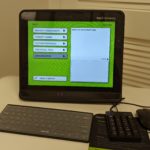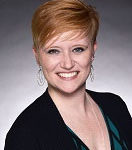
The entrance to Dr. May’s office. Dr. May says a few technologies have changed the trajectory of her practice.
By Michelle May, OD, FCOVD
Nov. 2, 2022
Practice improvements in the form of new technologies can make a huge difference to patient care and your ability to differentiate your practice from the competition. Here are the details on two technology solutions that make up a significant percentage of our gross income and one software that increased our patient recall by 10 percent.
Technology to Better Diagnose Oculomotor Dysfunction
In 2020, we brought in RightEye, an eye-tracking system that measures and analyzes eye movement behavior. This technology has changed how we assess eye movements in the diagnosis of oculomotor dysfunction and has improved our ability to objectively quantify various types of oculomotor dysfunction. The system also has a sensorimotor module for binocular vision screening. I was first introduced to the technology and tested it out at the annual College of Optometrists in Vision Development (COVD) meeting. After seeing the RightEye in action, I knew it would be an amazing addition to my vision therapy practice.
Editor’s Note: Eye-tracking diagnosis technology is also available from Oculogica, BrainScope and NeuroSync, among other manufacturers.

RightEye technology is one of the investments that Dr. May says has improved patient care while also giving a boost to profitability.
The purchase price was around $9,000, which I had initially planned to pay in two installments; unfortunately, just after delivery of the device COVID hit and my practice was shut down for 10 weeks. However, the company worked with me on a payment plan and I was able to pay without financing and keep the device.
Once we reopened and I was able to implement the technology, even at reduced capacity, we made back the purchase price within six months. There is a yearly subscription fee of $2,500, which is more than covered by two months’ worth of use (still at reduced capacity).
The RightEye software records and shows playback of eye movements, which is impactful in helping patients and parents understand exactly what the eyes are doing, what the dysfunction looks like and why/how it is related to the symptoms being experienced. For my vision therapy practice, having the ability to attach objective metrics to these visual system dysfunctions is huge. It also enables us to document medical necessity for insurance purposes and allows us to monitor progression and improvement in a more objective way that demonstrates the therapy is having the desired effects.
In addition to using the RightEye as part of our vision therapy evaluations, we offer it to all routine exams as an optional (cash-pay) screening test. Through screening at routine exams, we’ve been able to catch patients experiencing symptoms related to visual dysfunction that they didn’t realize were related to vision and would not have otherwise mentioned. We are then able to document the dysfunction and counsel them on treatment options.
The impact on profitability has been significant. RightEye testing alone has made up about 4 percent of our gross income since we first implemented it. The ability to visibly demonstrate oculomotor dysfunction also has an impact on vision therapy conversion rates, leading to more therapy patients and improving profitability further. When performed at the routine exam, parents see the testing we do for their kids and often opt to have it for themselves as well!
Other Articles to Explore
My biggest piece of advice to practices considering adding this type of technology is don’t limit its use to vision therapy patients; include it as an optional out-of-pocket screening at comprehensive exams – a surprisingly high number of people who are simply curious about the technology will opt in to do it. It’s a great way to help demonstrate how vision is about more than seeing 20/20 and it shows patients that we are keeping up with the latest technology to make an impression, potentially increasing word-of-mouth referrals.
OCT with Color Fundus Camera
In 2021, after many years of having it as my number one wish-list item, I purchased an OCT, choosing the Maestro 2 OCT/fundus camera. I had wanted an OCT since I opened my practice, but since my patient base is primarily younger, I would have been using the device infrequently, and therefore, the cost was prohibitive. The Maestro 2, because it also has a color fundus camera, allows for greatly expanded use of the device, so that it is now paying for itself. I was able to get a trade-in for my old Topcon fundus camera that brought the cost of the OCT to around $40,000, which I financed.
Editor’s Note: There are other OCT systems to choose from, including those from Visionix, ZEISS and Heidelberg Engineering, among other manufacturers.
This technology has had a significant impact on how we care for our ocular disease patients. We are now able to manage glaucoma patients (and suspects), AMD, high-risk medication patients, and others, in-house. We are able to offer higher quality of care for management of these patients and they don’t have to travel to specialists’ offices, which offers an added convenience for them.
The Maestro also has a screening function, simultaneously performing retinal imaging and an OCT of the entire posterior pole, which has allowed us to flag medical conditions that we may have previously missed without such a detailed view of the retina and optic nerve. Since the screening the Maestro provides generates more data than standalone fundus photos, we felt justified in increasing our fee for that service. Compared with the same period for last year, year-to-date we have collected 24 percent more gross revenue for screening services alone, while the number of exams performed has only increased by nine percent.
Year-to-date, procedures performed using the Maestro have made up almost seven percent of our gross income for the year, the bulk of that coming from retinal screenings. Using those screenings, we have also been able to diagnose more ocular disease, increasing the number of medical patients we are seeing, and, thus, the number of medical procedures we are performing and getting paid for.
If you’ve been putting off purchase of an OCT due to cost, I highly recommend an OCT that also has fundus photo capabilities. The ability to perform OCT, imaging and anterior segment testing helps the machine pay for itself and improves profitability while allowing you to provide high-quality patient care.
Automated Patient Recall & Online Review Generation
While we were closed for routine eyecare during the COVID shutdown, I looked into many patient recall and communication systems. When we reopened, we wanted to recall patients who were past due for exams without incurring the expense of direct-mail campaigns. I felt electronic recall would appeal more to, and be more successful with, our younger patient base. We also wanted a way to be able to communicate with our patients via text as well as increase the number of positive Google reviews to help with our online reputation management.
After researching various options, I ultimately invested in automated recall technology from AutoRemind. We also use this software to communicate with patients via text and to help generate new online reviews. I am currently in the process of adding an additional feature to contact patients who have an outstanding balance. Autoremind has a wide variety of other features that I currently don’t use, but would be available to me in the future should the needs of my practice change. They offer service packages, or you can choose which services you’d like to use à la carte (which is what I did).
Editor’s Note: There are many other recall systems to choose from, including Weave, Demandforce, Solutionreach and Simplifeye, among other recall/patient communication technologies.
On-boarding with the technology was straightforward and took an hour or less. The onboarding specialist helped me decide what settings I wanted and set it all up for me. Fees are charged monthly with pricing that includes a subscription fee plus additional fees based on the number of e-mails and texts that are sent per month.
Implementation of electronic recall has allowed us to make sure patients are returning when they are due for an examination, ensuring their ocular health is being monitored. In addition, we are now able to text patients, reaching them in a way that is more convenient and accessible for them and saving staff time, as sending texts is much faster than making phone calls and leaving voicemails.
Our recall system is set up to target patients who haven’t been seen in our office within a certain time frame. This time frame is customizable, and the messages go out via text and e-mail. Autoremind integrates with our EHR software to get phone numbers and e-mail addresses and recall notices are sent out automatically, so this is a “set it and forget it” type of system. When we first implemented the service, we saw a large influx of patients who were past due for exams, and now that those recalls are going out regularly, we see a steady stream of existing patients being recalled, about 10 percent more than before.
The reputation management system is set up to contact any patient who has an encounter that has been marked “complete” in our EHR software, though we can specify which appointment types this includes. At the end of each day, that day’s patients receive a text and e-mail asking them to rate their experience. Those who report positively are automatically directed to Google to leave an online review. Since activating this feature, and without any additional effort on our end asking for reviews, we’ve received on average 2-3 new positive reviews per month (where previously we would ask patients to review us and it could take 3-6 months to get this many new reviews). This has been huge since many of our new patients have told us they selected our office based on our positive reviews.
The technology available to us as eyecare providers continues to grow and improve at a rapid pace. I have been fortunate to be able to implement these technologies into my practice to upgrade, not only the quality of care that we provide, but boost practice health and profitability as well.
 Michelle May, OD, FCOVD, is the owner of Advanced Family Vision Care in Gambrills, Md. To contact her: DrMayAFVC@gmail.com
Michelle May, OD, FCOVD, is the owner of Advanced Family Vision Care in Gambrills, Md. To contact her: DrMayAFVC@gmail.com

























